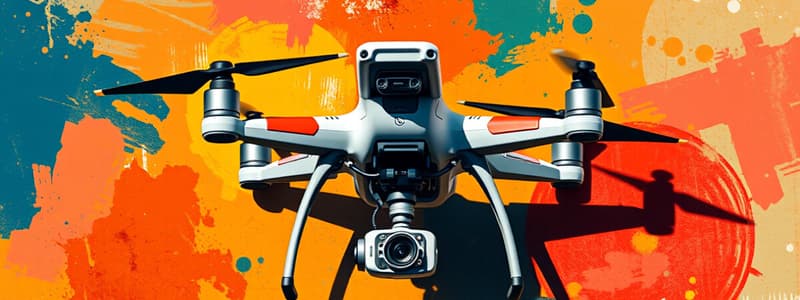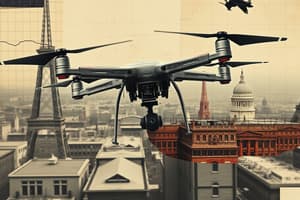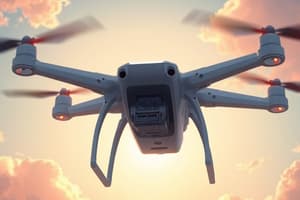Podcast
Questions and Answers
What is the purpose of dragging the last waypoint slightly outside the building during mission setup?
What is the purpose of dragging the last waypoint slightly outside the building during mission setup?
- To optimize area coverage for effective mapping (correct)
- To trigger more satellite connections
- To ensure the drone stays within the designated area
- To set the maximum altitude for the mission
Which camera setting is recommended to minimize motion blur during the mission?
Which camera setting is recommended to minimize motion blur during the mission?
- Shutter speed of at least 1/250 second
- Shutter speed of at least 1/2000 second
- Shutter speed of at least 1/500 second
- Shutter speed of at least 1/1000 second (correct)
What overlap percentage should be set for effective data capture in a single grid mission?
What overlap percentage should be set for effective data capture in a single grid mission?
- 60%
- 80% (correct)
- 90%
- 70%
What action should be taken if the auto-exposure settings become unresponsive?
What action should be taken if the auto-exposure settings become unresponsive?
What altitude is recommended for effective mission coverage?
What altitude is recommended for effective mission coverage?
What should be verified before initiating a mission?
What should be verified before initiating a mission?
What is the purpose of enabling 'active connect' during a mission?
What is the purpose of enabling 'active connect' during a mission?
What action is advisable if there are notable undulations in the terrain during the mission?
What action is advisable if there are notable undulations in the terrain during the mission?
What should the operator do if issues arise with the app during the flight?
What should the operator do if issues arise with the app during the flight?
Which of the following must be avoided for safety during the drone's flight?
Which of the following must be avoided for safety during the drone's flight?
Powering on the drone is not necessary to set up the mission.
Powering on the drone is not necessary to set up the mission.
The desired overlap for images during a single grid mission should be set at 90%.
The desired overlap for images during a single grid mission should be set at 90%.
Camera tilt adjustments can be made through the app's control panel.
Camera tilt adjustments can be made through the app's control panel.
Switching to attitude mode can help stabilize the drone's flight control in emergencies.
Switching to attitude mode can help stabilize the drone's flight control in emergencies.
The recommended altitude for effective mission coverage is 200 feet.
The recommended altitude for effective mission coverage is 200 feet.
Flashcards are hidden until you start studying
Study Notes
Mission Setup for Drone Operation
- Powering on the drone is necessary to set up the mission; satellites must be connected for mapping functions.
- Remote control must be turned on and connected to the phone via cable for a successful mission setup.
Configuring Mission Parameters
- New mission setup requires dragging the last waypoint slightly outside the building for optimal area coverage.
- Desired overlap for images set at 80% for effective data capture in a single grid mission.
- Enable 'active connect' for connectionless functionality during the mission.
Camera Settings Adjustments
- Camera tilt set through the app's control panel; white balance should be set to 'Sunny' for consistent lighting.
- Aim for a shutter speed of at least 1/1000 second to minimize motion blur; adjust via the right wheel control.
- If auto-exposure settings are unresponsive, use a workaround by clicking camera button multiple times to regain control.
Altitude and Flight Options
- Recommended altitude set at 151 feet for effective mission coverage.
- Options to view the drone’s camera feed provided in the app, accessible through bottom screen icons.
Launching the Mission
- Before starting the mission, verify all settings: overlap at 80%, camera with shutter priority, white balance on Sunny, and confirmed altitude.
- Initiate the mission by pressing the start button and addressing terrain awareness if the terrain has notable undulations.
Monitoring and Control During Flight
- Keep vigilant watch over the drone during flight to ensure compliance with safety protocols (avoid flying over people).
- The app will indicate when photos are being captured during the flight.
Emergency Controls and Safety Procedures
- To regain control of the drone in cases of app issues, switch to and from GPS mode.
- For preventing flyaways, input the drone into attitude mode to stabilize flight control.
Pre-Mission Considerations
- Regularly monitor battery health; good record keeping can eliminate the necessity for pre-flight battery tests.
- Follow the rules of takeoff and landing outlined in safety operations training, ensuring alignment of the pilot and drone's orientation.
Mission Setup for Drone Operation
- Power on the drone and connect to satellites for mapping functions.
- Ensure remote control is turned on and linked to the phone via cable for mission setup.
Configuring Mission Parameters
- Drag last waypoint slightly outside the building to enhance area coverage.
- Set desired image overlap at 80% for effective data capture in a grid mission.
- Activate 'active connect' for connectionless functionality during the mission.
Camera Settings Adjustments
- Adjust camera tilt using the app's control panel; set white balance to 'Sunny' for consistent lighting.
- Aim for a shutter speed of at least 1/1000 second to reduce motion blur; adjust this via the right wheel control.
- If auto-exposure settings fail, click the camera button multiple times to regain control.
Altitude and Flight Options
- Recommended altitude for missions is 151 feet to optimize coverage.
- Access the drone’s camera feed through the app, using icons located at the bottom of the screen.
Launching the Mission
- Verify all settings before starting: 80% overlap, shutter priority for the camera, white balance on Sunny, and confirmed altitude.
- Initiate the mission by pressing the start button, paying attention to any terrain undulations.
Monitoring and Control During Flight
- Maintain vigilance over the drone during flight to adhere to safety protocols, particularly avoiding flight over people.
- The app will signal when photos are captured throughout the flight.
Emergency Controls and Safety Procedures
- To regain control of the drone during app malfunctions, switch between GPS mode and manual control.
- Prevent flyaways by engaging attitude mode to stabilize flight control.
Pre-Mission Considerations
- Continuously monitor battery health to avoid unexpected issues; good record-keeping minimizes the need for pre-flight battery tests.
- Follow takeoff and landing protocols as defined in safety operations training, ensuring proper alignment between the pilot and the drone's orientation.
Mission Setup for Drone Operation
- Power on the drone and connect to satellites for mapping functions.
- Ensure remote control is turned on and linked to the phone via cable for mission setup.
Configuring Mission Parameters
- Drag last waypoint slightly outside the building to enhance area coverage.
- Set desired image overlap at 80% for effective data capture in a grid mission.
- Activate 'active connect' for connectionless functionality during the mission.
Camera Settings Adjustments
- Adjust camera tilt using the app's control panel; set white balance to 'Sunny' for consistent lighting.
- Aim for a shutter speed of at least 1/1000 second to reduce motion blur; adjust this via the right wheel control.
- If auto-exposure settings fail, click the camera button multiple times to regain control.
Altitude and Flight Options
- Recommended altitude for missions is 151 feet to optimize coverage.
- Access the drone’s camera feed through the app, using icons located at the bottom of the screen.
Launching the Mission
- Verify all settings before starting: 80% overlap, shutter priority for the camera, white balance on Sunny, and confirmed altitude.
- Initiate the mission by pressing the start button, paying attention to any terrain undulations.
Monitoring and Control During Flight
- Maintain vigilance over the drone during flight to adhere to safety protocols, particularly avoiding flight over people.
- The app will signal when photos are captured throughout the flight.
Emergency Controls and Safety Procedures
- To regain control of the drone during app malfunctions, switch between GPS mode and manual control.
- Prevent flyaways by engaging attitude mode to stabilize flight control.
Pre-Mission Considerations
- Continuously monitor battery health to avoid unexpected issues; good record-keeping minimizes the need for pre-flight battery tests.
- Follow takeoff and landing protocols as defined in safety operations training, ensuring proper alignment between the pilot and the drone's orientation.
Studying That Suits You
Use AI to generate personalized quizzes and flashcards to suit your learning preferences.




